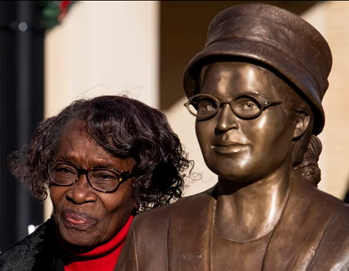The Civil Rights Movement has had a number of iconic leaders, people like Martin Luther King, Jr., Malcolm X, Ralph Abernathy, and Rosa Parks whose names are known by virtually every American and whose fame has very often gone beyond our borders. But a movement is not a movement without those whose names do not make the headlines, who are not discussed in history classes, or who are not commemorated in statues.

One such foot soldier of the Civil Rights Movement of the 1950s and 60s is Mary Louise Smith. Still alive today, Mary Louise was a trailblazer whose actions helped spark the world famous Montgomery Bus Boycott of 1955-1956. On October 21, 1955, she refused to give up her seat to a white woman and was therefore arrested for failure to obey segregation orders, and became one of four litigants in the anti-segregation case Browder v. Gayle. A month and a half later Rosa Parks refused to give up her seat on a bus and the rest, as they say, is history.
Although Parks became the face of the movement to end bus segregation, it is good to remember people like Smith - people who courageously took a stand, but who have become footnotes rather than headlines. For me, Smith is also worthy of attention because she is a Catholic and came from an incredibly important Black Catholic enclave that existed within the decidedly anti-Black, anti-Catholic Alabama of the time.
Just as there are few people who have heard of Mary Louise Smith, neither do many have any knowledge of the 36-acre campus known as the City of St. Jude. Founded in 1934, it was not only the first ministry for Black Catholics in Montgomery, but in the entire state of Alabama. Fr. Harold Purcell’s dream was to bring “light, hope and dignity” to families like those of Mary Louise through not only a parish church, but through a school, social center, and hospital.
Sadly, the St. Jude Educational Institute - the alma mater of Mary Louise, and a school that was integrated from its beginning - closed its doors in 2014. The St. Jude Catholic Hospital - the first integrated hospital in the southeastern U.S., and the birthplace of the two oldest children of Martin and Coretta King - was converted to low-cost housing for senior citizens in 1992.
But both the social center and the parish of St. Jude are thriving, and Mary Louise is still a member of the parish that has nurtured her throughout her life.
Fr. Purcell went to his grave knowing that he had helped many people to achieve their dreams and to live lives of great dignity, but he was saddened not to have been able to live long enough to see the final piece of the puzzle of the City of St. Jude fit into place. In 1958, six years after his death, the Father Purcell Memorial Exceptional Children's Center was opened. This center provides high-quality health care to children with developmental disabilities and children who suffer from mental or physical damage resulting from abuse.
The City of St. Jude is now on the U.S. National Register of Historic Places and houses a museum dedicated to the events that took place on campus during the final night of the marches from Selma to Montgomery in March of 1965. Around 10,000 marchers camped out at the City of St. Jude and were a part of the Stars of Freedom rally that boasted numerous entertainers and activists from Joan Baez, Pete Seeger, and Dick Gregory to Tony Bennett, Johnny Mathis, and Lena Horne.
In the garden outside the museum stands a fitting memorial to remind us what people like Fr. Purcell and Mary Louise Smith were focused on when they heard the call to act for justice driven by their Catholic faith. The statue, titled “Homeless Jesus”, depicts a person wrapped in a blanket and lying on a park bench. It is meant to bring to our hearts the words of Jesus that “whatever you did for one of these least brothers of Mine, you did for Me.”
And as for a memorial to honor Mary Louise Smith, one would have to have a keen eye to notice how her home town has honored her. In 2019 a statue of Rosa Parks was unveiled in Montgomery, and Mary Louise was in attendance. A picture from that day shows Smith posing next to the statue of her hero and inspiration. Outside the scope of that photograph, at the feet of Mary Louise and the statue of Rosa, and embedded in the cement lay four granite markers. Each piece of granite has carved into it the name of one of the four courageous women who preceded Rosa in refusing to give up their seats and move to the back of the bus: Aurelia Browder, Susie McDonald, Claudette Colvin, and, of course, Mary Louise Smith.
A.M.D.G.